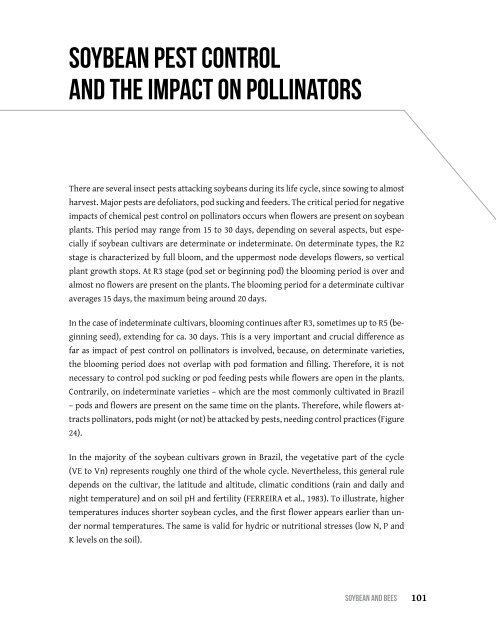Soybean and Bees
Create successful ePaper yourself
Turn your PDF publications into a flip-book with our unique Google optimized e-Paper software.
<strong>Soybean</strong> pest control<br />
<strong>and</strong> the impact on pollinators<br />
There are several insect pests attacking soybeans during its life cycle, since sowing to almost<br />
harvest. Major pests are defoliators, pod sucking <strong>and</strong> feeders. The critical period for negative<br />
impacts of chemical pest control on pollinators occurs when flowers are present on soybean<br />
plants. This period may range from 15 to 30 days, depending on several aspects, but especially<br />
if soybean cultivars are determinate or indeterminate. On determinate types, the R2<br />
stage is characterized by full bloom, <strong>and</strong> the uppermost node develops flowers, so vertical<br />
plant growth stops. At R3 stage (pod set or beginning pod) the blooming period is over <strong>and</strong><br />
almost no flowers are present on the plants. The blooming period for a determinate cultivar<br />
averages 15 days, the maximum being around 20 days.<br />
In the case of indeterminate cultivars, blooming continues after R3, sometimes up to R5 (beginning<br />
seed), extending for ca. 30 days. This is a very important <strong>and</strong> crucial difference as<br />
far as impact of pest control on pollinators is involved, because, on determinate varieties,<br />
the blooming period does not overlap with pod formation <strong>and</strong> filling. Therefore, it is not<br />
necessary to control pod sucking or pod feeding pests while flowers are open in the plants.<br />
Contrarily, on indeterminate varieties – which are the most commonly cultivated in Brazil<br />
– pods <strong>and</strong> flowers are present on the same time on the plants. Therefore, while flowers attracts<br />
pollinators, pods might (or not) be attacked by pests, needing control practices (Figure<br />
24).<br />
In the majority of the soybean cultivars grown in Brazil, the vegetative part of the cycle<br />
(VE to Vn) represents roughly one third of the whole cycle. Nevertheless, this general rule<br />
depends on the cultivar, the latitude <strong>and</strong> altitude, climatic conditions (rain <strong>and</strong> daily <strong>and</strong><br />
night temperature) <strong>and</strong> on soil pH <strong>and</strong> fertility (FERREIRA et al., 1983). To illustrate, higher<br />
temperatures induces shorter soybean cycles, <strong>and</strong> the first flower appears earlier than under<br />
normal temperatures. The same is valid for hydric or nutritional stresses (low N, P <strong>and</strong><br />
K levels on the soil).<br />
SoybeAn <strong>and</strong> bees<br />
101


